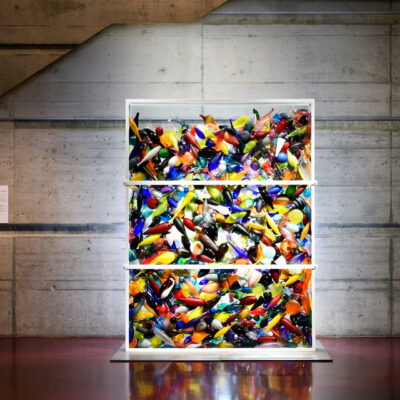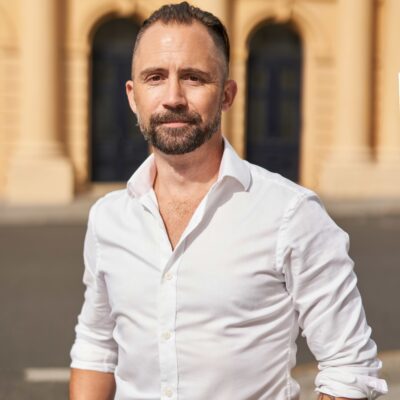Melinda Infante was born in 1994, and lives and works in Geneva, Switzerland. Trained in the medical field, she is an artist focused on recreating the intricate processes of the body, often working on material at a detailed, cellular level. Infante explores various media such as clay, paper, rope and thread, materials that for her evoke the tones and nuances of skin textures. She currently works with Japanese or Latin American paper, selected for its unique texture and distinctive fibrousness. Using these materials, she creates works in which repeated motifs evoke the pulse of life. Each cut, fold and shade of paper becomes a visual narrative, guiding her creative process. With her creations, Japanese paper becomes more than a medium, it is a metaphor for life, for the body, a delicate skin with fine fibres that captures the essence of existence.

Kristen Knupp: I visited you at your apartment/gallery about two and a half years ago and at that time you were working with ficus bark paper and the concept of cell division and the creation of living things. Are you still working with that material and those concepts?
Melinda Infante: I identify myself more and more as an artist working with the paper of the world. I work with Korean, Japanese, Latin American, Thai, and Chinese paper so I look at all the paper of the world and take the best ones. I am working often with Japanese paper which is very fibrous, cellular, and it is also very soft and very fine. It is a paper that inspires me very much considering my history in the medical world. It is a paper where one sees the resemblance with the skin, the body, and the fibers which we have in our bodies. Japanese paper has really inspired the last year of my work. In addition, I have been working with paper from Latin America because it is very thick and natural. I like to use materials that are found, in the tradition of the art pauvre movement, such as using natural elements like leaves, wood, and also essences, like tea, beets, and avocado, to tint the paper. I use tea to tint the paper and transform it, giving it a second life. A leaf, for example, is something one has seen before, but as soon as it is transformed, people are more interested. They feel part of the elements, and this releases their emotions.

Melinda Infante work at Mabe Gallery, Geneva. Photo credit: Marine de Rouge
KK: You have worked in the medical field as a maternity nurse and a midwife. How did you make the transition between the medical world and the art world.
MI: I have always done the two together. Ever since I was little, I have been creating, painting, and making things. But when you tell your parents that you want to do either medicine or art, I think most parents would tell their children to do medicine. Medicine was also an area that fascinated me, as we are the biggest works of art, so I was especially interested in the human body. I have no regrets about studying medicine, but I always had the need to create, make drawings, work with fibres and stamps, etc. I always did the two together. During the pandemic I had the time to paint, draw, and create. People told me that I should sell my art but it took me some time to believe that I could actually sell it. I began to show it, little by little, and it was very successful. Then some galleries contacted me, and I thought, why not follow my other passion after medicine. Then I became pregnant and had my daughter, and since then I have had more time to focus on my art.


KK: I have seen that you have had many exhibition this year, where have you been showing your art?
MI: I am really grateful to be represented by three galleries in Paris, and three galleries in Geneva, and I am lucky to have amazing gallerists. This past year I have shown work at Stay Tuned Gallery in Geneva and at Le Chalet Zannier hotels in Megève, as well as at Mabe Gallery in Geneva. In February, 2024, I will have an opening at Gutmans Gallery in Geneva, and it will be advertised on the flags that are all along the lake, so it will be very visible.
KK: Which artists inspire you?
MI: I am a big fan of Pierrette Bloch, a Paris-born Swiss artist who worked with many materials including “poor” materials such as ink, paper, mesh, and horsehair. I really like her history and her work. I also like Claude Viallat from the Supports/Surfaces movement. I like the repetition of shapes in his work, because it is in simplicity and in using the material directly, and not in all the things that surround that, that one finds true meaning. I also like Japanese art and Spanish art, since I am of Spanish descent. I adore Joan Miró and all the big Spanish artists.


KK: What are your projects for this year, what are your plans?
MI: I mentioned the galleries where I will show my art, and I am going to focus on making more art in large format. I will show in various places this spring and summer including St. Tropez and Menorca. I also want to explore certain materials in more detail such as ceramics. I would also love to travel to Japan and see the museums and culture there. Of course, I will go to artgenève and be inspired by all the work I see there. When I come home after a day at an art fair, I am so excited that I am not able to sleep that night.
For more information go to Melinda Infantes on Instagram.
Cover image: Melinda Infante at Mabe Gallery, Photo credit: Marine de Rougé




